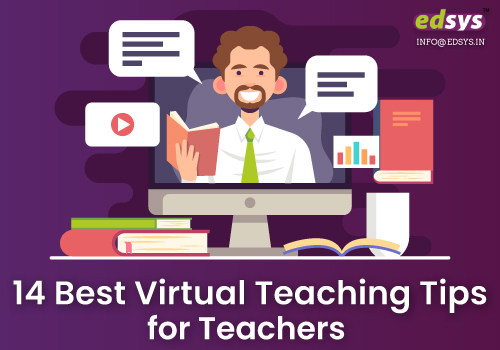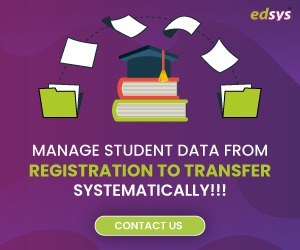Categories(658 Blogs)
Select Category
Watch Right Now
Teacher App - Class
Schedule & Attendance Management App
Parent App from Edsys

Best School Bus Tracking System

Cashless School - For Smart Schools of Tomorrow


14 Best Virtual Teaching Tips for Teachers

Schools and colleges have been locked for more than two months. Exams have been postponed. The Corona pandemic has almost frozen the entire education sector. However, many educational institutes are encouraging their teachers to start online classes.
The transition from traditional classroom teaching to online teaching can be difficult for many. There has been no buffer or training period for both teachers and students to get used to this new medium of teaching.
One day, all classes were being held in schools, and the very next day, teachers were being asked to log on to online meeting apps and start taking classes online. It is not only the teachers who are grappling with the sudden change, but the students are also struggling to adapt the new mode of teaching.
It is time for teachers to change and adapt themselves to this new method of teaching. In this blog, we will discuss 14 best virtual teaching tips for teachers.
1. Take Time to Learn the Technology
One of the biggest challenges for teachers is technology.You need to understand how to use learning platforms and online apps.
Unless you are a computer science teacher, the odds of using a computer for teaching are almost equal to zero.
So, it’s ok, if you’re not proficient with the apps and systems. Get a technical person to help you out.
Learn how to create online lesson plans, insert videos and images as you take a class or you can even build an online self-grading quiz. Once you get the hang of the technology, half your work will be done.
2. Spend a couple of sessions to familiarise your students with the technology
Children these days are well-versed in technology. So, using a computer system or a mobile phone is not a big deal for them. You need to guide your students on how to use the online learning platforms.
They may also need to use MS Office tools like Word or Excel for their assignments.
Higher class students may need to use slides to present their projects. Give time to students to understand how to use technology.
If possible, try to get their parents to guide them in getting well-versed with technology.
3. Keep your Equipment Ready and Test it
Don’t wait for five minutes before your class starts, to set up your desktop or mobile.
Have everything set up and tested, a few times before you start the class.
This way, the time needed to setup your system will not eat into your class time. Also, check if you have good network connectivity and enough data balance for the online session.
4. Have a backup plan
Even after you’ve prepared well and tested all your equipments, anything could happen.
Always be prepared to face the worst, you may face network issues or power failures due to bad weather or any other problem. Try to keep a backup for every instance.
You can have an email that lists all tasks that your students can do until you get back. Or if your laptop doesn’t have power, start working from your mobile phone.
5. Don’t use your Regular Lesson Plan for the Online class
In the traditional classroom teaching, you will have a face-to-face conversation.
Your lesson plans will be based on the facilities available in the class. However, this may not work for online teaching. For example, you can give a talk for 10-15 minutes in the classroom and ensure the attention of your students.
However, that may not be the case in an online class. Long-winded speeches may end up on deaf ears. So, keep the context and concept but change the delivery!
6. Create a Clear Lesson Outline
As explained in the previous tip, you cannot use the same learning plan that you prepare for a classroom session for online sessions.
You need to come up with a different lesson outline including digital elements, interactive activities, and lot more to keep kids engaged.
There are also many educational software applications available online that you can use to make your lessons more interesting.
7. Add variety to the lesson plan
In traditional teaching, you would probably have worked with a blackboard/whiteboard and teaching aids.
In online teaching, your teaching aids are videos, gifs, slides, text, online tests, and images.
Use these different digital elements while delivering your lessons. In the initial stages, you may have to spend hours on preparing for one class. However, you can reorganize the content and reuse them based on different learning objectives.
8. Look for ways to increase engagement
When you teach in a classroom, you can gauge a student’s reaction, which is almost impossible in online teaching.
It can be solved to an extent if every student is online at the same time.
But still, it would be difficult to get connected with each student.
So, think of ways in which you can interact with your students and allow them to communicate during the session.
9. Plan activities to keep students focussed
An average human can focus on a particular activity continuously for 20 minutes.
And when you’re teaching via the online medium, you can expect it to drop a little more. This is because the student is not able to see the teacher directly.
And at the same time, the chances are high for a student to get distracted at home.. So, while planning your lesson, have numerous activities to keep the students focused on the lesson.
To add to the interest, have some surprises lined up. Maybe you can have a fun game with the first ten students who join the class. Or you could give them refundable credits when they ace a test.
They can use the credits when they forget to turn in an assignment or need extra time to work on a project.
10. Connect with Students outside Teaching Sessions
Stay connected with students even when you don’t have an online session. You could send them emails or messages.
Try to have one-on-one sessions with students. These sessions can be just 5 to 10 minutes.
During these personal sessions, you can ask the student to share his/her difficulties with the online teaching methodologies or things they would enjoy learning during the session.
11. Be Flexible with your Teaching and Learning plan
Online teaching requires a lot of flexibility, especially with your teaching methods.
Sometimes because of network connectivity or other factors, students may not be able to log in on time.
They may have trouble adjusting to the technology. So, your teaching methods also need to be flexible and student-centric.
12. Reach out to Unresponsive Students
Reach out to students who don’t respond to your messages or emails, or don’t attend your online sessions.
Try to talk to the parents to find out if there is any reason for the same. If there are any difficulties, work it out with the students and the parents to find an effective solution.
13. Create Different Mediums of Response
When you’re preparing for your online teaching session, remember to clearly mention how the student needs to respond to you.
If the students need to turn in an assignment – how should they do it? Should they post the files on a Drive or should they mail it to you?
Also, if they want to answer the questions you ask during the session, should they talk back to you or should they text back to you.
It is important to clearly explain the response medium you expect from the student before you ask the question or share a test.
14. Upskill and Update yourself
The changes due to Corona can be a common thing in future. . There are many e-learning apps that offer interactive and interesting ways of learning different concepts.
So, you need to use this time to upskill yourself about the e-learning platforms and technologies.
Learn how to use apps to create lesson plans and ways in which you can automate certain teaching tasks.
Teachers who are ready to learn and update themselves are the ones who can succeed in these tiring situations. .
We hope that these tips will help you tune your teaching skills to suit the rapidly evolving digital medium. Change is the only thing that is constant. As technology finds its way into the educational sector, teachers who embrace the change will be better equipped to train the future generation.
Wishing you happy and effective online teaching!
Recent Blogs
Our Educational Services
Popular Blogs
Subscribe

SUBSCRIBE TO OUR NEWSLETTER
Sign Up and Recieve the Latest News
Don’t Worry, We Don’t SpamExplore Our Extensive Researched Educational App Directory
Visit Now

















